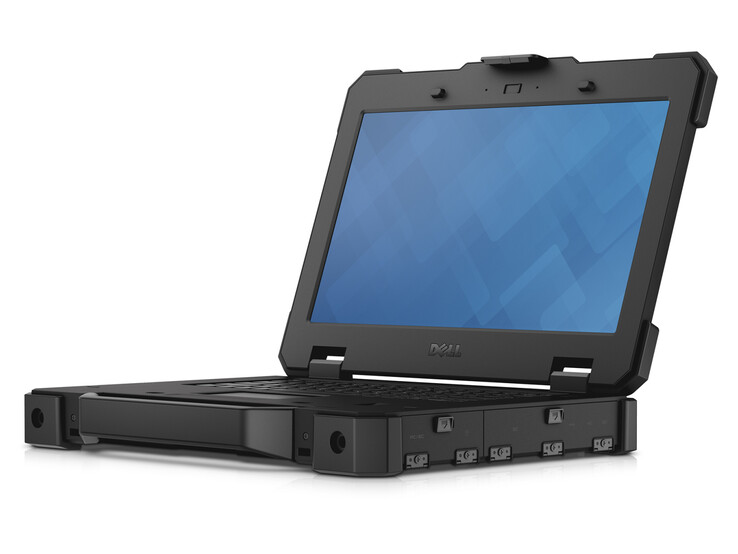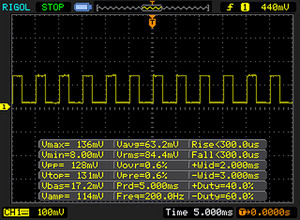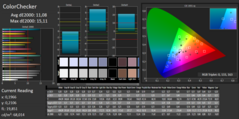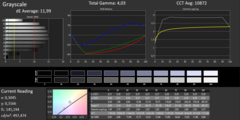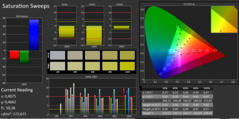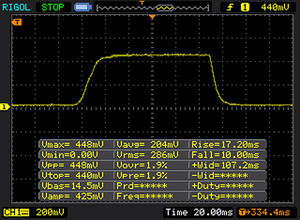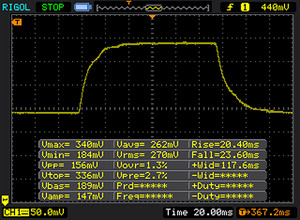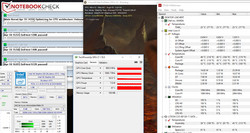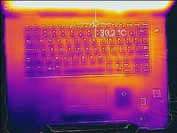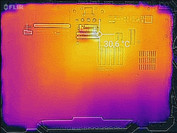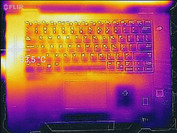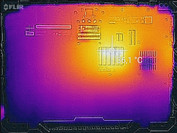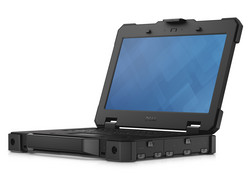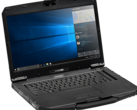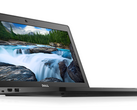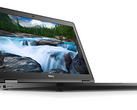Dell Latitude 14 7414 Rugged Extreme (6200U, HD) Laptop Review

The Dell Latitude 14 7414 Rugged Extreme is a robust laptop made for harsh, technologically hostile environments. This device is not a newcomer as we have already tested an identically constructed Haswell iteration of this computer three years ago. For the new model, Dell relies on Skylake processors. There are no competitors to be found in our database.
Since both tested models are constructed identically we will not make further statements about the case, equipment, input devices or the speakers. Those details can be found in our review of the Latitude 14 7404.
A model similar to our test device, but with a 256 SSD is available online for around $4250 (incl. VAT). At the time this review, a refurbished model equipped with a 512 GB SSD and 16 GB of RAM is available heavily discounted for a price of $1350 (incl. VAT).
| SD Card Reader | |
| average JPG Copy Test (av. of 3 runs) | |
| Dell Latitude 14 Rugged 5414 | |
| Dell Latitude 14 7414 Rugged Extreme | |
| maximum AS SSD Seq Read Test (1GB) | |
| Dell Latitude 14 7414 Rugged Extreme | |
| Dell Latitude 14 Rugged 5414 | |
| Networking | |
| iperf3 transmit AX12 | |
| Acer TravelMate X349-G2 | |
| Dell Latitude 14 7414 Rugged Extreme | |
| Lenovo ThinkPad T470s-20HGS00V00 | |
| iperf3 receive AX12 | |
| Lenovo ThinkPad T470s-20HGS00V00 | |
| Acer TravelMate X349-G2 | |
| Dell Latitude 14 7414 Rugged Extreme | |
Display
The Latitude is equipped with the same 14-inch touchscreen display as its Haswell predecessor. The high-contrast screen is bright, viewing angle-stable and comes with a native resolution of 1366x768 pixels. Nonetheless, our measurements show slight differences, which is to be expected as two identical panels never actually match one hundred percent.
Unfortunately, the display shows PWM flicker with a frequency of 200 Hz below 20% display brightness. For susceptible users, this might lead to headaches or problems with the eyes.
| |||||||||||||||||||||||||
Brightness Distribution: 81 %
Center on Battery: 493 cd/m²
Contrast: 930:1 (Black: 0.53 cd/m²)
ΔE ColorChecker Calman: 11.08 | ∀{0.5-29.43 Ø4.78}
ΔE Greyscale Calman: 11.99 | ∀{0.09-98 Ø5}
56% sRGB (Argyll 1.6.3 3D)
36% AdobeRGB 1998 (Argyll 1.6.3 3D)
38.49% AdobeRGB 1998 (Argyll 3D)
55.8% sRGB (Argyll 3D)
37.22% Display P3 (Argyll 3D)
Gamma: 4.03
CCT: 10872 K
| Dell Latitude 14 7414 Rugged Extreme IPS, 1366x768, 14" | Dell Latitude 14 Rugged 5414 IPS, 1920x1080, 14" | Dell Latitude 14 7414 Rugged Extreme LED, UWVA, 1366x768, 14" | |
|---|---|---|---|
| Display | -0% | -2% | |
| Display P3 Coverage (%) | 37.22 | 37.23 0% | 36.35 -2% |
| sRGB Coverage (%) | 55.8 | 55.2 -1% | 54.5 -2% |
| AdobeRGB 1998 Coverage (%) | 38.49 | 38.48 0% | 37.59 -2% |
| Response Times | -24% | ||
| Response Time Grey 50% / Grey 80% * (ms) | 43 ? | 49 ? -14% | |
| Response Time Black / White * (ms) | 27 ? | 36 ? -33% | |
| PWM Frequency (Hz) | 200 ? | 198 ? | |
| Screen | 19% | -1% | |
| Brightness middle (cd/m²) | 493 | 1152 134% | 529 7% |
| Brightness (cd/m²) | 456 | 1067 134% | 482 6% |
| Brightness Distribution (%) | 81 | 86 6% | 83 2% |
| Black Level * (cd/m²) | 0.53 | 1.08 -104% | 0.61 -15% |
| Contrast (:1) | 930 | 1067 15% | 867 -7% |
| Colorchecker dE 2000 * | 11.08 | 10.04 9% | 10.64 4% |
| Colorchecker dE 2000 max. * | 15.11 | 19.43 -29% | |
| Greyscale dE 2000 * | 11.99 | 10.47 13% | 11.79 2% |
| Gamma | 4.03 55% | 2.42 91% | 2.73 81% |
| CCT | 10872 60% | 5576 117% | 6893 94% |
| Color Space (Percent of AdobeRGB 1998) (%) | 36 | 35 -3% | 34.85 -3% |
| Color Space (Percent of sRGB) (%) | 56 | 63 13% | |
| Total Average (Program / Settings) | -2% /
9% | -2% /
-1% |
* ... smaller is better
Screen Flickering / PWM (Pulse-Width Modulation)
| Screen flickering / PWM detected | 200 Hz | ≤ 20 % brightness setting | |
The display backlight flickers at 200 Hz (worst case, e.g., utilizing PWM) Flickering detected at a brightness setting of 20 % and below. There should be no flickering or PWM above this brightness setting. The frequency of 200 Hz is relatively low, so sensitive users will likely notice flickering and experience eyestrain at the stated brightness setting and below. In comparison: 53 % of all tested devices do not use PWM to dim the display. If PWM was detected, an average of 8108 (minimum: 5 - maximum: 343500) Hz was measured. | |||
Display Response Times
| ↔ Response Time Black to White | ||
|---|---|---|
| 27 ms ... rise ↗ and fall ↘ combined | ↗ 17 ms rise | |
| ↘ 10 ms fall | ||
| The screen shows relatively slow response rates in our tests and may be too slow for gamers. In comparison, all tested devices range from 0.1 (minimum) to 240 (maximum) ms. » 66 % of all devices are better. This means that the measured response time is worse than the average of all tested devices (20.2 ms). | ||
| ↔ Response Time 50% Grey to 80% Grey | ||
| 43 ms ... rise ↗ and fall ↘ combined | ↗ 20 ms rise | |
| ↘ 23 ms fall | ||
| The screen shows slow response rates in our tests and will be unsatisfactory for gamers. In comparison, all tested devices range from 0.165 (minimum) to 636 (maximum) ms. » 70 % of all devices are better. This means that the measured response time is worse than the average of all tested devices (31.6 ms). | ||
Performance
With the Latitude 14 7414 Rugged Extreme, Dell offers a resilient 14-inch laptop made for use in adverse environments.
Processor
Dell has equipped its Latitude with a Core i5-6300U (Skylake) Intel dual core processor. The CPU is one of the f ULV all-rounders (TDP: 15 watts) and performs decently in all application areas. The processor clocks at a base speed of 2.4 GHz. In turbo mode, it achieves frequencies of up to 2.9 GHz (both cores) or 3 GHz (one core), respectively. Turbo mode is available in both power supply mode and battery mode.
Whether the turbo keeps this level can be observed during a 30-minute run of the Cinebench R15 Multithread benchmark test. From the first to the second run the performances drops a little. During the third run it normalizes again and remains at this level during successive runs. An actual performance slump cannot be observed.
According to our CPU tests the Latitude clearly outpaces its predecessor. The latter is equipped with a weaker Haswell processor.
| Cinebench R10 | |
| Rendering Multiple CPUs 32Bit | |
| Dell Latitude 14 7414 Rugged Extreme | |
| Dell Latitude 14 Rugged 5414 | |
| Dell Latitude 14 7414 Rugged Extreme | |
| Rendering Single 32Bit | |
| Dell Latitude 14 Rugged 5414 | |
| Dell Latitude 14 7414 Rugged Extreme | |
| Dell Latitude 14 7414 Rugged Extreme | |
| Geekbench 3 | |
| 32 Bit Single-Core Score | |
| Dell Latitude 14 7414 Rugged Extreme | |
| Dell Latitude 14 Rugged 5414 | |
| 32 Bit Multi-Core Score | |
| Dell Latitude 14 7414 Rugged Extreme | |
| Dell Latitude 14 Rugged 5414 | |
| Geekbench 4.0 | |
| 64 Bit Single-Core Score | |
| Dell Latitude 14 Rugged 5414 | |
| Dell Latitude 14 7414 Rugged Extreme | |
| 64 Bit Multi-Core Score | |
| Dell Latitude 14 7414 Rugged Extreme | |
| Dell Latitude 14 Rugged 5414 | |
| Geekbench 4.4 | |
| 64 Bit Single-Core Score | |
| Dell Latitude 14 7414 Rugged Extreme | |
| 64 Bit Multi-Core Score | |
| Dell Latitude 14 7414 Rugged Extreme | |
| JetStream 1.1 - Total Score | |
| Dell Latitude 14 Rugged 5414 | |
| Dell Latitude 14 7414 Rugged Extreme | |
System Performance
A solid processor and a zippy solid state disk allow for a well working system. The PC Mark Benchmark results testify that the laptop has more than enough resources to handle office and internet applications. A small performance increase can be achieved by adding a second working memory module (= dual-channel mode activated).
| PCMark 8 Home Score Accelerated v2 | 3655 points | |
Help | ||
| PCMark 8 - Home Score Accelerated v2 | |
| Dell Latitude 14 7414 Rugged Extreme | |
| Dell Latitude 14 Rugged 5414 | |
| Dell Latitude 14 7414 Rugged Extreme | |
Storage devices
Dell has utilized an SSD by LiteOn, an M.2-2880 model with a capacity of 128 GB. Out of the box, around 80 GB is available for usage while the rest is occupied by the recovery partition and the Windows operating system. The SSD transfer rates are decent, but not top-notch.
| Dell Latitude 14 7414 Rugged Extreme Liteonit CV3-8D128 | Dell Latitude 14 Rugged 5414 Liteonit CV3-8D128 | Dell Latitude 14 7414 Rugged Extreme Liteon IT LCS-256L9S-11 | |
|---|---|---|---|
| CrystalDiskMark 3.0 | 11% | 62% | |
| Read Seq (MB/s) | 474.3 | 487.7 3% | 504 6% |
| Write Seq (MB/s) | 207.4 | 316.7 53% | 419.9 102% |
| Read 512 (MB/s) | 265.2 | 351 32% | 385.1 45% |
| Write 512 (MB/s) | 167.2 | 185.8 11% | 423.3 153% |
| Read 4k (MB/s) | 26.98 | 27.72 3% | 35.85 33% |
| Write 4k (MB/s) | 60.1 | 62.5 4% | 95 58% |
| Read 4k QD32 (MB/s) | 304.5 | 267.8 -12% | 329.5 8% |
| Write 4k QD32 (MB/s) | 176.1 | 158.2 -10% | 328.9 87% |
Graphics Card
Our test device comes with an integrated Intel HD Graphics 520 GPU. It supports DirectX 12 and reaches clock speeds of up to 950 MHz. The 3D-Mark-11 results show an ordinary performance considering the graphics core. Again, an increase in performance can be achieved by adding another working memory module. This activates the dual-channel mode, which makes better use of the GPU.
| 3DMark 11 Performance | 1502 points | |
Help | ||
| 3DMark 11 - 1280x720 Performance GPU | |
| Dell Latitude 14 Rugged 5414 | |
| Acer TravelMate X3 X349-M-7261 | |
| Acer TravelMate P449-M-7407 | |
| Dell Latitude 14 7414 Rugged Extreme | |
Gaming Performance
The hardware of the Latitude is able to accommodate smooth gaming experience on the screen, as long as system requirements are low. Most games can only be displayed on low resolutions and low quality settings. By activating the dual-channel mode (filling the second RAM slot), an increase in gaming performance can be achieved, but even then, performance hungry games such as “Mass Effect Andromeda” remain unplayable.
Customers who require more graphic performance can choose to add a dedicated Radeon R7 M360 graphics core (+ $220) in the Dell shop.
| low | med. | high | ultra | |
|---|---|---|---|---|
| BioShock Infinite (2013) | 46.8 | 25.9 | 21.5 |
Emissions & Energy management
System Noise
The fan of the Latitude remains still when the system is idle. Even under load the fan does not start up immediately. It takes up its work only after around 8 minutes when the system gets exhausted with our stress test. During the test, it does not produce much noise.
The laptop, however, emits other noises. From time to time an electronic splutter can be heard, for example, during performing SSD tests (CrystalDiskMark, AS SSD).
Noise level
| Idle |
| 30.2 / 30.2 / 30.2 dB(A) |
| Load |
| 30.2 / 31.7 dB(A) |
 | ||
30 dB silent 40 dB(A) audible 50 dB(A) loud |
||
min: | ||
Temperature
Our stress tests (Prime95 and FurMark run for at least one hour) are handled in a similar manner when in power supply mode or in battery mode. The processor clocks to 2.9 GHz for several seconds and throttles at a constant 1.5 GHz. After a few minutes the fan takes up its work leading to an increase in clock speed to about 2 GHz. The graphics processing unit mostly runs with full force (950 MHz). Later in the test process, it occasionally drops down to 200 MHz.
On the outside, the laptop does not really heat up. The 30-degree Celsius (~86 degree Fahrenheit) line is only reached in two places during the stress test.
(+) The maximum temperature on the upper side is 30.2 °C / 86 F, compared to the average of 34.3 °C / 94 F, ranging from 21.2 to 62.5 °C for the class Office.
(+) The bottom heats up to a maximum of 30 °C / 86 F, compared to the average of 36.8 °C / 98 F
(+) In idle usage, the average temperature for the upper side is 25.2 °C / 77 F, compared to the device average of 29.5 °C / 85 F.
(+) The palmrests and touchpad are cooler than skin temperature with a maximum of 25.5 °C / 77.9 F and are therefore cool to the touch.
(+) The average temperature of the palmrest area of similar devices was 27.6 °C / 81.7 F (+2.1 °C / 3.8 F).
Speakers
Dell Latitude 14 7414 Rugged Extreme audio analysis
(-) | not very loud speakers (71 dB)
Bass 100 - 315 Hz
(±) | reduced bass - on average 14.6% lower than median
(+) | bass is linear (4.6% delta to prev. frequency)
Mids 400 - 2000 Hz
(±) | higher mids - on average 5% higher than median
(+) | mids are linear (4.8% delta to prev. frequency)
Highs 2 - 16 kHz
(+) | balanced highs - only 2.9% away from median
(+) | highs are linear (5.3% delta to prev. frequency)
Overall 100 - 16.000 Hz
(±) | linearity of overall sound is average (15.6% difference to median)
Compared to same class
» 15% of all tested devices in this class were better, 4% similar, 81% worse
» The best had a delta of 7%, average was 21%, worst was 53%
Compared to all devices tested
» 23% of all tested devices were better, 4% similar, 73% worse
» The best had a delta of 4%, average was 24%, worst was 134%
Apple MacBook 12 (Early 2016) 1.1 GHz audio analysis
(+) | speakers can play relatively loud (83.6 dB)
Bass 100 - 315 Hz
(±) | reduced bass - on average 11.3% lower than median
(±) | linearity of bass is average (14.2% delta to prev. frequency)
Mids 400 - 2000 Hz
(+) | balanced mids - only 2.4% away from median
(+) | mids are linear (5.5% delta to prev. frequency)
Highs 2 - 16 kHz
(+) | balanced highs - only 2% away from median
(+) | highs are linear (4.5% delta to prev. frequency)
Overall 100 - 16.000 Hz
(+) | overall sound is linear (10.2% difference to median)
Compared to same class
» 7% of all tested devices in this class were better, 2% similar, 91% worse
» The best had a delta of 5%, average was 18%, worst was 53%
Compared to all devices tested
» 4% of all tested devices were better, 1% similar, 94% worse
» The best had a delta of 4%, average was 24%, worst was 134%
Frequency diagram in comparison (Toggle check boxes on or off!)
Energy Consumption
While idling we measure a maximum power consumption of 16.8 watts. The bright screen is responsible for this high value. During our stress tests a power consumption of 36.3 watts is measured. The nominal power of the power adapter is 90 watts.
| Off / Standby | |
| Idle | |
| Load |
|
Key:
min: | |
Battery Runtime
Our realistic Wi-Fi test simulates the workload when connecting to webpages. In this test the “Balanced” power plan is activated, the screen brightness is set to 150 cd/m² and energy saving options are turned off. The Latitude reaches a run time of 10:28 h. Our test device is equipped with a 97 Wh battery. Dell offers batteries with lower capacities (58, 65 or 87 Wh), as well.
| Battery Runtime - WiFi Websurfing | |
| Dell Latitude 14 7414 Rugged Extreme | |
| Dell Latitude 14 Rugged 5414 | |
Pros
Cons
Verdict
The Dell Latitude 14 7414 Rugged Extreme is a 14-inch laptop built for extraordinary situations. Its interior is protected from dust, liquids, drops and heat. Compared to the predecessor nothing has changed on the outside. Improvements can only be seen inside. Haswell makes way for Skylake, which improves processing power in the new models. Despite this performance increase, elevated noise levels and heat emissions are nowhere to be found. The Latitude remains silent and rather cool at all times. What is more, battery life is very good.
The Latitude 14 7414 is equipped for use in adverse environments.
A solid-state drive enables a snazzy running system. Exchanging the SSD would be possible without much effort. We are already acquainted with the backlit keyboard from the laptop´s predecessor. It exhibits a comfortable typing experience. The display remains the same bright, high-contrast, viewing angle-stable model as we have seen in the Haswell predecessor. Dell refrains from an upgrade in terms of the port selection. Thunderbolt 3, DisplayPort or Type-C USB are not even offered as options.
Dell Latitude 14 7414 Rugged Extreme
- 04/20/2017 v6 (old)
Sascha Mölck




